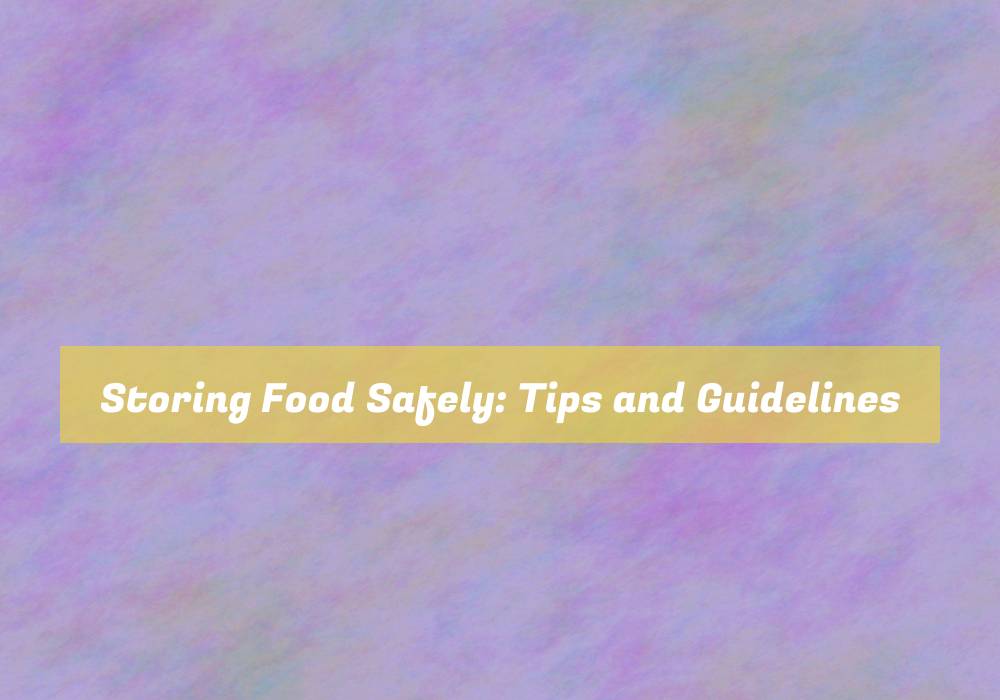Storing Food Safely: Tips and Guidelines
So, you think youG??ve got this whole food storage thing down pat, huh? Well, hold on just a moment. ThereG??s more to it than meets the eye.
Whether youG??re a seasoned home cook or just starting to dabble in the culinary arts, ensuring that your food is stored safely is crucial. You might be surprised by some of the common mistakes people make when it comes to storing food.
But fear not, because in the next few paragraphs, youG??ll uncover some valuable tips and guidelines that will help you navigate the world of safe food storage like a pro.
Importance of Proper Food Storage
Proper food storage is crucial for maintaining freshness and preventing foodborne illnesses. By storing food correctly, you can ensure that it stays safe to eat and maintains its quality for a longer period.
When food isnG??t stored properly, itG??s at risk of spoilage, which can lead to food poisoning and other health hazards. For example, leaving perishable items like meat and dairy products at room temperature for too long can cause harmful bacteria to multiply rapidly.
Using airtight containers and wrapping food properly can help prevent spoilage and extend the shelf life of many items. ItG??s important to store different types of food in the appropriate conditions, such as keeping perishable items refrigerated and storing dry goods in a cool, dry place.
Additionally, following the G??first in, first outG?? rule can help prevent food waste by ensuring that older items are used before newer ones.
Proper food storage not only safeguards your health but also saves money by reducing food waste. By taking the time to store your food correctly, you can enjoy fresher, safer meals and minimize the risk of foodborne illnesses.
Guidelines for Refrigerator Storage
When organizing your refrigerator, remember to place raw meat and seafood on the bottom shelf to prevent any potential drips from contaminating other foods. ItG??s crucial to store perishable items like dairy, eggs, and ready-to-eat foods on the middle shelves where the temperature is most consistent. Keep leftovers, deli meats, and packaged foods on the top shelf. This arrangement helps prevent cross-contamination and ensures that raw juices donG??t drip onto ready-to-eat foods.
Additionally, utilize the refrigerator door for condiments, jams, and other items with high acidity or sugar content, as the temperature in the door fluctuates more than the main compartment. When storing fruits and vegetables, be mindful of ethylene-producing foods like apples and avocados, as they can cause nearby produce to ripen and spoil more quickly.
Utilize clear storage containers to help identify and access foods easily, and always label leftovers with the date to ensure you consume them within a safe timeframe. By following these guidelines, you can maintain a well-organized and safe refrigerator that keeps your food fresh and free from contamination.
Tips for Pantry Organization
To keep your kitchen well-organized, consider implementing efficient pantry organization techniques that complement your refrigerator storage guidelines.
Start by decluttering your pantry and getting rid of expired items. Group similar items together, such as canned goods, grains, and snacks, to make it easier to find what you need. Use clear containers or labels to identify different items and their expiration dates.
Consider installing shelving or racks to maximize vertical space and keep items visible. Keep frequently used items at eye level for easy access, and store less frequently used items on higher or lower shelves. Utilize storage baskets or bins to contain smaller items and prevent clutter.
ItG??s also important to regularly clean and organize your pantry to maintain a sanitary environment. By following these pantry organization tips, you can ensure that your food items are easily accessible and that you can keep track of expiration dates, ultimately reducing food waste and saving money.
Best Practices for Freezer Storage
Consider organizing your freezer by grouping similar items together in designated sections to maximize space and easily locate what you need. Start by placing meats in one section, frozen vegetables in another, and prepared meals in a separate area. This not only helps you find items quickly but also keeps your freezer more organized.
When storing items in the freezer, ensure theyG??re properly wrapped or sealed to prevent freezer burn. Use airtight containers or freezer bags to maintain the quality of the food and prevent odors from spreading.
ItG??s also essential to label and date items before placing them in the freezer, so you can easily identify how long theyG??ve been stored. Remember to rotate older items to the front, so theyG??re used first, reducing the risk of items getting forgotten and becoming freezer burnt.
Additionally, regularly declutter your freezer by removing expired or freezer-burnt items. Following these best practices for freezer storage will help you maintain a well-organized and efficient freezer space.
Conclusion
In conclusion, proper food storage is essential for maintaining the freshness and safety of your food.
By following the guidelines for refrigerator and freezer storage, as well as organizing your pantry, you can prevent foodborne illness and reduce food waste.
Remember to check expiration dates, use airtight containers, and keep your storage areas clean and organized.
By taking these simple steps, you can ensure that your food stays safe and delicious for as long as possible.






